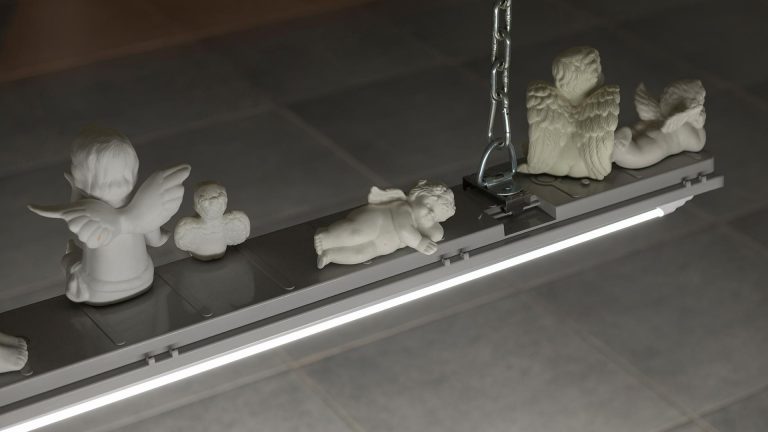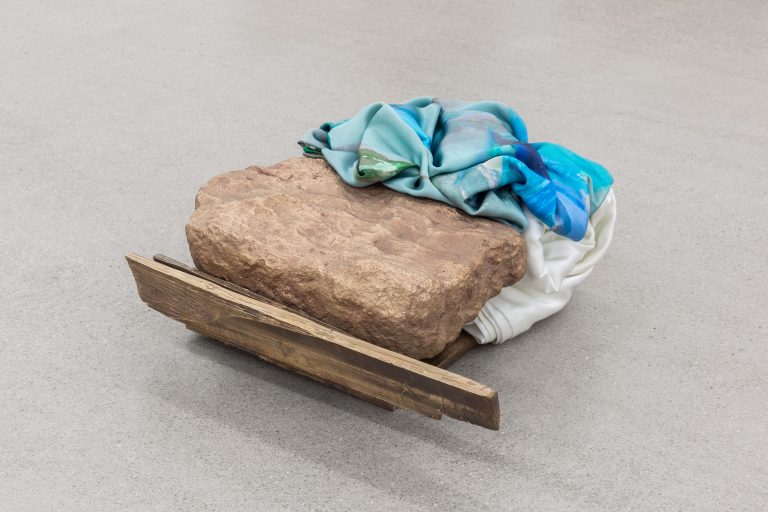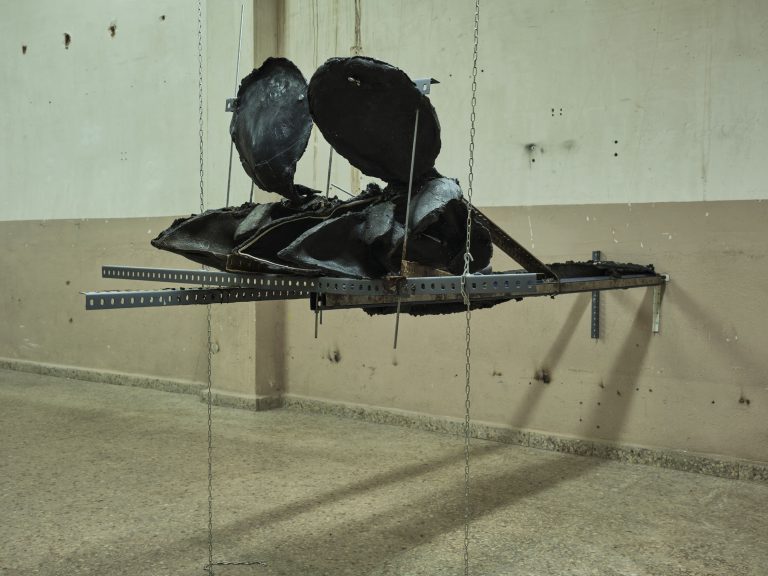Artist: Viktoria Binschtok
Exhibition title: Cheap Vapes and Power Drink
Venue: L21 Gallery, Mallorca, Spain
Date: February 12 – March 12, 2021
Photography: Natasha Lebedeva / all images copyright and courtesy of the artist and L21 Gallery, Mallorca
FLICKERING PUFFS
“There is no such thing as globalisation, there is only virtualisation. What is being effectively globalised by instantaneity is time.”1 Paul Virilio
“Cheap Vapes and Power Drinks” shimmers the purple neon on a roadside we drive by. I take a picture on the go with the smartphone which is then automatically indexed in the cloud. Right away, it belongs to the thousands of millions of images that compose the flow of information that is archived within fibre optic cable. Somewhere inside a heated power plant, online worlds copy-paste forming a constellation of images. As the car speeds up on the hillside avenue, we encounter the bright “Juice Bar” signposts piling up with gyms and other sorts of recreational places. The images I capture of them circulate within the “vicious cycles of audiovisual capitalism”, to paraphrase Hito Steyerl ́s seminal essay “In Defense of the Poor Image”2. In this paper, Steyerl discusses the role of digital technology in shaping image dissemination and positions the Jpeg as the bastard of an original image, no longer the real thing as it surfs algorithms, pop-up ads and social networks ultimately producing another kind of reality. As I look out through the window’s glass I wonder, to what extent are we in control of the digital representation of the world around us which includes ourselves?
The practice of Viktoria Binschtok considers the interconnectedness of the image in an increasingly global and technological world, at the same time than reflects upon the status of photography as it has been bluntly altered by the introduction of smartphones into our communication channels. The work Statue/Fish belongs to the series Cluster3 (2014-2017), in which the artist has fed her own photographs into computer-based algorithms that search for images that are visually related. She then makes a selection of these pairings and stages speculative windows into the world, combining her own photographs and the algorithms’. Taking this process further, Binschtok has been developing the series Networked Images4 (2017-present) in which she connects the different image worlds (hers and the found) by physically overlapping them. As stated by the artist, “with this method, I could represent the abstract concept of the migration of images (image flow). By re-staging the found jpegs, I transfer this fleeting data to physical space, freezing it in time”.
Ultimately, what is at issue in her work, is the collective point of view and the self-reproducing aspect of the image. She reverts the logic of image consumerism, turning distraction into contemplation. The image is thus liberated from the vaults of digital uncertainty, from the poor image to the high-res picture. The question of how do we perceive individual images in relation to one another remains open, as camera rolls shine on displays then disappear again.
- Quoted by Steve Redhead in Paul Virilio: Theorist for an Accelerated Culture, Edinburgh University Press, 2004.
- Hito Steyerl, In Defense of the Poor Image. Published on e-flux Journal #10, November 2009.
- Etymologically speaking, “cluster” comes from old English clyster “a number of things growing naturally together,” probably from the same root as clot (n.). Meaning “a number of persons, animals, or things gathered in a close body”.
- Note the relation within the phrase “net-worked-images”.
-Cristina Ramos González
Viktoria Binschtok (b. 1972, Moscow, Rusia) is a Berlin-based artist, whose work is based on the interplay between found images, algorithms and the creation of original work. Binschtok’s practice examines the limits of our image-based society, the notions of public and private when it comes to image- sharing and their relationship to AI and randomised algorithms.
Her work has been featured in numerous exhibitions at key galleries and museums, including the Centre Pompidou Paris (2020); Henie Onstad Art Center, Norway (2020); MdbK Leipzig (2019); National Taiwan Museum of Fine Arts (2019); Museum Folkwang Essen (2017, 2014); Klemm’s, Berlin (2019, 2017, 2015), Andrew Rafacz Gallery, Chicago (2018) and Arts Santa Monica, Barcelona (2013). Her work is part of the Kunstmuseum Bonn, Zabludowicz Collection, Collection Helga de Alvear and Centre Pompido, amongst others.
Viktoria Binschtok, Cheap Vapes and Power Drink, 2021, exhibition view, L21 Gallery, Mallorca
Viktoria Binschtok, Cheap Vapes and Power Drink, 2021, exhibition view, L21 Gallery, Mallorca
Viktoria Binschtok, Cheap Vapes and Power Drink, 2021, exhibition view, L21 Gallery, Mallorca
Viktoria Binschtok, Cheap Vapes and Power Drink, 2021, exhibition view, L21 Gallery, Mallorca
Viktoria Binschtok, Cheap Vapes and Power Drink, 2021, exhibition view, L21 Gallery, Mallorca
Viktoria Binschtok, Purple Head, 2020, Three digital c-prints, (60 x 40 cm each)
Viktoria Binschtok, Cheap Vapes & Power Drink, 2018, Two digital c-prints (custom-made framed), (100 x 78 cm each)
Viktoria Binschtok, Pasta Lady, 2020, Two digital c-prints, (111 x 57 cm each)
Viktoria Binschtok, Statue / Fish, 2016, Two digital c-prints, 100 x 100 cm (Statue), 35 x 45cm
Viktoria Binschtok, Legs & Knives, 2018, Four digital c-prints, (110 x 43 cm each)
















